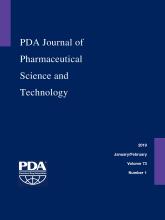Abstract
This case study is the first to address the risk, at the device-to-vial interface, of a spike pushing a stopper into a vial. It was performed after healhcare workers at cancer care hospitals complained about the risk of possible exposure to hazardous injectable drugs during the transfer if the spike pushed the stopper into the vial. This case study took a three-step approach to understand the device-to-vial interface and the factors that determine stopper push-in force threshold and spike puncture force, respectively. The results show that the stopper push-in force threshold varies with the spike size, stopper properties, and stopper design, while the spike puncture force is determined by spike design, spike surface lubricity, stopper properties, and stopper design. This case study suggests that to mitigate the risk of stopper push-in, the spike puncture force needs to be significantly lower than the stopper push-in force threshold, measured with a flat-tip test probe having the same outside diameter as typically used spikes. In addition, although some factors that impact stopper push-in force threshold also impact spike puncture force in the same trend, such as stopper material, other factors that impact stopper push-in force threshold do not impact spike puncture force and vice versa. For example, the spike length and cross-section area contribute to stopper push-in force threshold but do not have significant impact on puncture force. It would be misleading to just compare the absolute values of spike puncture forces but neglect the dimensional factors. From the stopper and spike compatibility perspective, this case study provides a methodology to quantify the risk of the stopper being pushed into the vial by the spike and suggests a process to prevent the stopper push-in from occurring. The study also shows that the human factor is another important element in the stopper push-in issue. It emphasizes the need for a joint effort for risk mitigation across the board among stopper manufacturers, spike manufacturers, pharmaceutical manufacturers, device manufacturers, and hospitals (pharmacies and healthcare workers). Device and drug developers need to properly select and test stoppers and containers with intended spikes. Healthcare workers need to use compatible stoppers and spikes and need to use them correctly.
LAY ABSTRACT: It is critical to protect healthcare workers from exposure to hazardous drugs such as cancer drugs. Since the 1970s, much work has focused on the development of closed-system drug-transfer devices (CSTD) to ensure the containment of spills, sprays, and vapors. However, other gaps in the cancer drug transfer process have been overlooked. For example, one gap at the device-to-stopper interface is the compatibility of vial stopper and spike. This case study is the first to address the risk at the device-to-vial interface of stopper push-in by the spikes during the transfer of hazardous injectable drugs. It serves to understand the issue of spikes pushing stoppers into the vial. It shows that the push-in force threshold varies with the spike diameters, stopper materials, and design. The spike puncture force is impacted by spike design, surface lubricity, stopper materials, and design. To prevent the stopper from being pushed into the vial, causing splashes and exposure to the drug, it is important to coordinate the stopper push-in force threshold and spike puncture force and optimize the spike dimensions. The human factor also affects the drug transfer. This case study provides a methodology to quantify the stopper push-in risk from a force and dimensional perspective.
- © PDA, Inc. 2019
PDA members receive access to all articles published in the current year and previous volume year. Institutional subscribers received access to all content. Log in below to receive access to this article if you are either of these.
If you are neither or you are a PDA member trying to access an article outside of your membership license, then you must purchase access to this article (below). If you do not have a username or password for JPST, you will be required to create an account prior to purchasing.
Full issue PDFs are for PDA members only.
Note to pda.org users
The PDA and PDA bookstore websites (www.pda.org and www.pda.org/bookstore) are separate websites from the PDA JPST website. When you first join PDA, your initial UserID and Password are sent to HighWirePress to create your PDA JPST account. Subsequent UserrID and Password changes required at the PDA websites will not pass on to PDA JPST and vice versa. If you forget your PDA JPST UserID and/or Password, you can request help to retrieve UserID and reset Password below.






